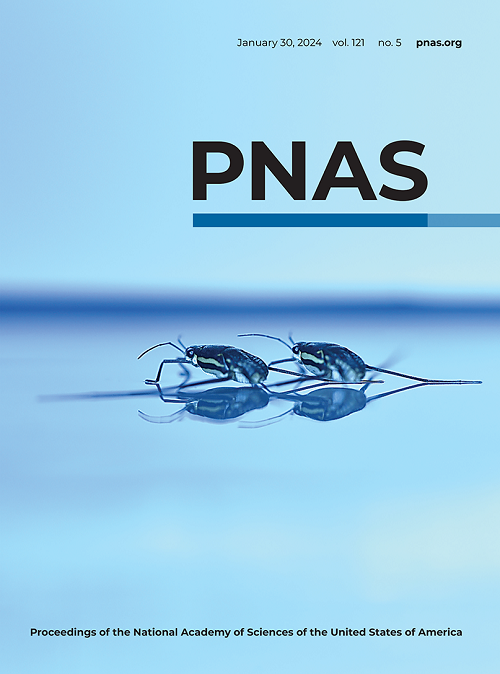O-GlcNAcylation of enolase 1 serves as a dual regulator of aerobic glycolysis and immune evasion in colorectal cancer.
IF 9.4
1区 综合性期刊
Q1 MULTIDISCIPLINARY SCIENCES
Proceedings of the National Academy of Sciences of the United States of America
Pub Date : 2024-10-24
DOI:10.1073/pnas.2408354121
引用次数: 0
Abstract
Aerobic glycolysis and immune evasion are two key hallmarks of cancer. However, how these two features are mechanistically linked to promote tumor growth is not well understood. Here, we show that the glycolytic enzyme enolase-1 (ENO1) is dynamically modified with an O-linked β-N-acetylglucosamine (O-GlcNAcylation), and simultaneously regulates aerobic glycolysis and immune evasion via differential glycosylation. Glycosylation of threonine 19 (T19) on ENO1 promotes its glycolytic activity via the formation of active dimers. On the other hand, glycosylation of serine 249 (S249) on ENO1 inhibits its interaction with PD-L1, decreases association of PD-L1 with the E3 ligase STUB1, resulting in stabilization of PD-L1. Consequently, blockade of T19 glycosylation on ENO1 inhibits glycolysis, and decreases cell proliferation and tumor growth. Blockade of S249 glycosylation on ENO1 reduces PD-L1 expression and enhances T cell-mediated immunity against tumor cells. Notably, elimination of glycosylation at both sites synergizes with PD-L1 monoclonal antibody therapy to promote antitumor immune response. Clinically, ENO1 glycosylation levels are up-regulated and show a positive correlation with PD-L1 levels in human colorectal cancers. Thus, our findings provide a mechanistic understanding of how O-GlcNAcylation bridges aerobic glycolysis and immune evasion to promote tumor growth, suggesting effective therapeutic opportunities.烯醇化酶 1 的 O-GlcNAcylation 是结直肠癌有氧糖酵解和免疫逃避的双重调控因子。
有氧糖酵解和免疫逃避是癌症的两大特征。然而,人们对这两个特征如何通过机理联系起来促进肿瘤生长还不甚了解。在这里,我们发现糖酵解酶烯醇化酶-1(ENO1)被O-连接的β-N-乙酰葡糖胺(O-GlcNAcylation)动态修饰,并通过不同的糖基化同时调节有氧糖酵解和免疫逃避。ENO1上苏氨酸19(T19)的糖基化可通过形成活性二聚体促进其糖酵解活性。另一方面,ENO1 上丝氨酸 249(S249)的糖基化会抑制其与 PD-L1 的相互作用,减少 PD-L1 与 E3 连接酶 STUB1 的结合,从而导致 PD-L1 的稳定。因此,阻断ENO1上的T19糖基化可抑制糖酵解,减少细胞增殖和肿瘤生长。阻断ENO1上的S249糖基化可减少PD-L1的表达,增强T细胞介导的针对肿瘤细胞的免疫力。值得注意的是,消除这两个位点的糖基化可与 PD-L1 单克隆抗体疗法协同促进抗肿瘤免疫反应。临床上,ENO1糖基化水平上调,并与人类结直肠癌中的PD-L1水平呈正相关。因此,我们的研究结果从机理上揭示了 O-GlcNAcylation 是如何连接有氧糖酵解和免疫逃避以促进肿瘤生长的,从而为有效的治疗提供了机会。
本文章由计算机程序翻译,如有差异,请以英文原文为准。
求助全文
约1分钟内获得全文
求助全文
来源期刊
CiteScore
19.00
自引率
0.90%
发文量
3575
审稿时长
2.5 months
期刊介绍:
The Proceedings of the National Academy of Sciences (PNAS), a peer-reviewed journal of the National Academy of Sciences (NAS), serves as an authoritative source for high-impact, original research across the biological, physical, and social sciences. With a global scope, the journal welcomes submissions from researchers worldwide, making it an inclusive platform for advancing scientific knowledge.

 求助内容:
求助内容: 应助结果提醒方式:
应助结果提醒方式:


